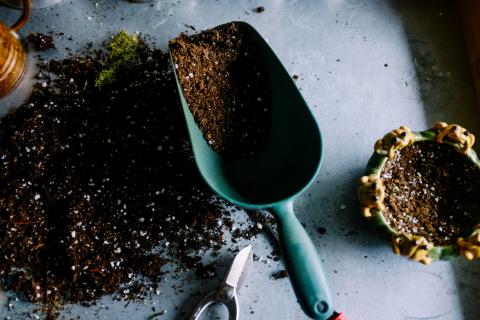What is the best soil for potted plants?

Going to the garden center to purchase potting mix can be a little overwhelming. With many types of products to choose from, it can be difficult to know which one will be best for the plants you intend to grow. Some are meant to be added to the garden or used to fill raised beds, while others are suitable for growing in containers or pots. Garden soils are typically intended for use in the ground and contain minerals and organic matter. They are not a good choice for containers because the soil can quickly become compacted and waterlogged, reducing air space around the roots. This can lead to poor or stunted growth. Garden soils can also contain weed seeds, insects and diseases if they haven’t been pasteurized.
Potting mixes (also called soilless mixes), on the other hand, are specifically made for growing potted plants. They are lightweight, retain moisture, and they supply plenty of air space around the roots. Air space is actually one of the most critical aspects of potting mix. If the roots don’t have enough air, a plant usually doesn’t survive. Although the ingredients tend to vary, good mixes always contain an organic component (peat moss, compost, bark), vermiculite or perlite (to help retain moisture), sand, nutrients and limestone. Some contain fertilizer or moisture-retaining treatments, usually indicated on the label. Knowing what is in the potting mix is key to determining whether it will be a good match for the plants you are trying to grow. General potting mixes will work fine for most annuals and vegetables grown in containers, but they may hold too much moisture for orchids, succulents or cacti. Specialty mixes are sold for these plants and, while not absolutely necessary, can provide benefits.
Potting Mix Ingredients
Peat is a special type of organic material that comes from decomposed plants in bogs. Most peat comes from sphagnum moss, hence it’s other common name, “peat moss.” Peat is a major component of almost all potting mixes because it retains moisture without becoming waterlogged, is lightweight, and does not become easily compressed.
Compost is occasionally included in potting mix for added nutrients. It can reduce air space in the soil and should be used sparingly for potted plants. Compost should make up no more than 1/3 of a potting mix.
Bark that has been ground and partially composted is often incorporated into less expensive potting mixes in place of peat. Bark provides good aeration but dries out more quickly than peat, requiring more frequent watering.
Coir is a fibrous material from coconut husks that is sometimes used in place of peat. It is similar to peat in that it retains water without becoming soggy.
Vermiculite is the product of heating mica chips. It is a gray, spongy material that increases water retention in mixes. It also holds on to nutrients and thus keeps fertilizer available for the plant roots for a longer period of time.
Perlite is a white volcanic rock that is reminiscent of Styrofoam. It is light weight and porous and is used to improve the drainage and aeration of potting mix.
Sand is another common component of potting mixes. It can improve drainage and is often added in large quantities to mixes intended for cacti and succulents.
Fertilizer is sometimes added to potting mixes, usually in a slow-release form that breaks down gradually over time when it comes in contact with water. Thus, small amounts of nutrients are released over the course of weeks. Eventually this initial source of nutrients will be exhausted, and potted plants will require additional fertilizer.
Moisture retaining treatments come with some potting mixes and are meant to reduce how often you need to water. These “hydrogels” or “water storing crystals” are polymers that have the ability to absorb large amounts of moisture and slowly release it as the soil dries. Their effectiveness diminishes over time, and eventually the potting mix dries out as any other. Potting mixes with moisture retaining treatments are suitable for potted annuals but are a poor choice for succulents or other drought tolerant plants.
The best potting mix for potted plants may vary slightly depending on what you are trying to grow. However, all quality mixes will be lightweight, fluffy and dry, and contain peat, coir, bark, perlite, or vermiculite. Avoid products that are compost-based or seem overly heavy – these won’t provide enough air space for roots. When in doubt, choose a peat-based general purpose mix, or make your own potting mix by combining the ingredients above. Many potting mix recipes exist online, and you can adjust the ratios of the added materials according to the needs of the plants you’re growing.
Got questions? The Ask UNH Extension Infoline offers practical help finding answers for your home, yard, and garden questions. Call toll free at 1-877-398-4769, Monday to Friday, 9 a.m. to 2 p.m., or e-mail us at answers@unh.edu.
Related Resource(s)
Do you love learning about stuff like this?
SUBSCRIBE TO Granite State Gardening newsletter
Got questions? The UNH Extension Yard and Garden Infoline offers practical help finding answers for your yard and garden questions.
Call toll free at 1-877-398-4769, Monday to Friday, 9 a.m. to 2 p.m., or fill out webform.
